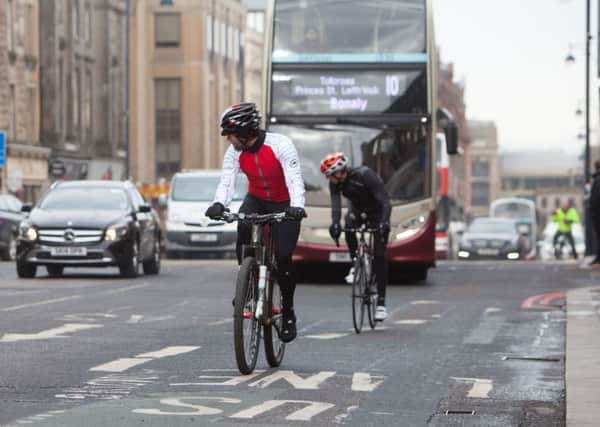Iain A Masterton: Cyclists as traffic managers '“ surely not?


And likewise, as a pedestrian, don’t you just hate having to co-exist with anything on wheels? Whichever way, it seems you just can’t win.
Our roads are not only poorly maintained, crowded and polluted, they are fundamentally dysfunctional. Even without the ‘roadworks from hell’ they seem purposely designed to offer the maximum inconvenience to the greatest number of road users.
Advertisement
Hide AdAdvertisement
Hide AdWhen we visit friends in Germany we occasionally borrow bikes and two things are obvious. Firstly, there is much better segregation of road use. Cycle lanes are generally separate, not a grudged metre of potholed road edge.
Secondly, cyclists seem to be less rushed and many bikes are good old-fashioned sit-up-and-beg machines. There are fewer Bradley Wiggins wannabes or two-wheeled cruise missiles.
Edinburgh has, thankfully, rationalised her bus lane times, but in other respects bus lanes still seem to fulfil a function incompatible with safe cycling. Bicycles – the smallest and most vulnerable road vehicles – are expected to share the lanes with 20-ton monsters. Why?
Take the A71 dual carriageway through Sighthill. There are parallel feeder roads on either side tailor-made to take cycle traffic away from the main carriageway, but this is actively discouraged. Underpasses which avoid the need to mix it with other traffic on roundabouts are explicitly barred to cyclists, and ironically the ‘No Cycling’ signs are amongst the cleanest and best maintained anywhere. It’s almost as if cyclists, being forced onto the main carriageway, are employed as a traffic management tool – buses must pull out to overtake, inhibiting the car lane.
If this is not the intention, finding ways to siphon cyclists away from the rest of the traffic seems such a no-brainer it is difficult to understand why it appears to be anathema to planners.
We don’t even have to find additional road space to achieve this in many cases. A signposted system of recommended routes and, more importantly, non-recommended ones, both within the city and on arterial commuter routes could improve the experience for everyone.
For example, further out on the A71, most cyclists using the Calders bypass section presumably aren’t doing so out of a desire to create tailbacks. It’s a full mile shorter and many times safer to use the direct route through East Calder and Midcalder, but there’s nothing to tell them that’s the better option. The same is true on most routes into Edinburgh and elsewhere too.
Signs cost money, of course, but avoidable accidents cost more. The case for being smarter in the way we share road space seems obvious – unless of course cyclists really are being seen as serendipitous unpaid traffic management. Perish the thought.
Iain A Masterton is a retired consultant software engineer.